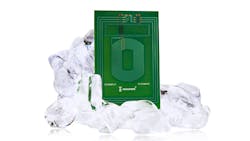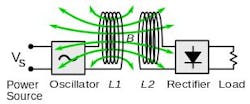Antenna Assemblies Bridge Major Wireless Charging Standards
Although there has been some consolidation among wireless charging standards, two major trade organizations—the AirFuel Alliance and Wireless Power Consortium (WPC)—are in the process of developing two different standards. While competition can sometimes breed innovation, the problem with having two different standards for the same technology is that manufacturers are forced to choose one or the other.
NuCurrent, a Chicago-based company that develops wireless power technology, appears to have taken steps toward erasing the boundaries between the standards. The company has invented an antenna assembly that can support all three major wireless charging standards, including the WPC's Qi (pronounced "chee") and the two standards from the AirFuel Alliance—which was formed by the merger of the Alliance for Wireless Power (A4WP) and Power Matters Alliance (PMA) earlier this year. The new group is expected to combine it predecessors’ respective standards.
The antenna assembly is capable of receiving wireless power from a specific transmitter. The Qi standard operates over antenna frequencies between 110 kHz and 250 kHz, the PMA standard between 200 kHz and 300 kHz, and the high frequency Aw4P standard at 6.78 MHz. The antenna provides nearly 80% efficiency with the Qi coil and is combined with a 10-watt A4WP coil—also known as a resonator—on the same 0.3-mm printed substrate.
NuCurrent is targeting ultra-thin smartphones and other “functionality-rich” connected devices with the new technology, according to an official statement from the company. The statement also confirmed that the new assemblies have entered full production. NuCurrent notes that its high-frequency capabilities make the antenna suitable for RF surface-mount components and induction heating.
Each wireless power frequency has its unique restrictions and benefits. At lower frequencies, the antennas can be thinner, more durable, and easier to integrate with printed circuit boards (PCBs). On the other hand, NuCurrent’s antennas also have to account for the so-called “skin effect” that occurs in conductive wires at high frequencies. At such frequencies, the alternating current (AC) in a standard wire is focused around the edges, wasting the center part of the wire and raising the resistance.
NuCurrent’s core technology is multi-layer (ML) wire, which splits the AC current over multiple smaller-diameter wires. The ML wires provide more available surface area for the current to flow, a characteristic that lends itself to higher efficiency, thinner form factor, and better durability. The design allows for different shapes of multi-layer, multi-turn (MLMT) wire. The other benefit is that the wires can be integrated directly onto a PBC or other substrate without any soldering.
The benefit of using ML wire is that it gives NuCurrent antennas an extremely high quality (Q) factor, or the ratio of apparent power to the power losses in a device. The Q factor can have a value between 0 and infinity, but it has been difficult for engineers to reach values higher than 1,000 for antenna coils. For mass production, values around 100 are typical.
The company’s website says that, when compared to a standard Qi-based PCB A6 coil at 100 kHz, NuCurrent’s printed coils have a quality factor greater than 20% (which Texas Instruments apparently confirmed in separate tests). When compared to printed coils using the A4WP standard, NuCurrent has recorded a 60% higher quality factor.
NuCurrent has long been involved in the wireless charging industry. The company started a strategic partnership with Molex and has been selected as the reference antenna for the systems of other wireless power manufacturers. These include Broadcom, with its BCM59350 chip, and Efficient Power Conversion Corp. NuCurrent’s resonators were selected for the first commercially available, Rezence-certified (the A4WP’s standard) products and the WPC’s standard antenna for in-vehicle charging.
About the Author

James Morra
Senior Editor
James Morra is the senior editor for Electronic Design, covering the semiconductor industry and new technology trends, with a focus on power electronics and power management. He also reports on the business behind electrical engineering, including the electronics supply chain. He joined Electronic Design in 2015 and is based in Chicago, Illinois.

